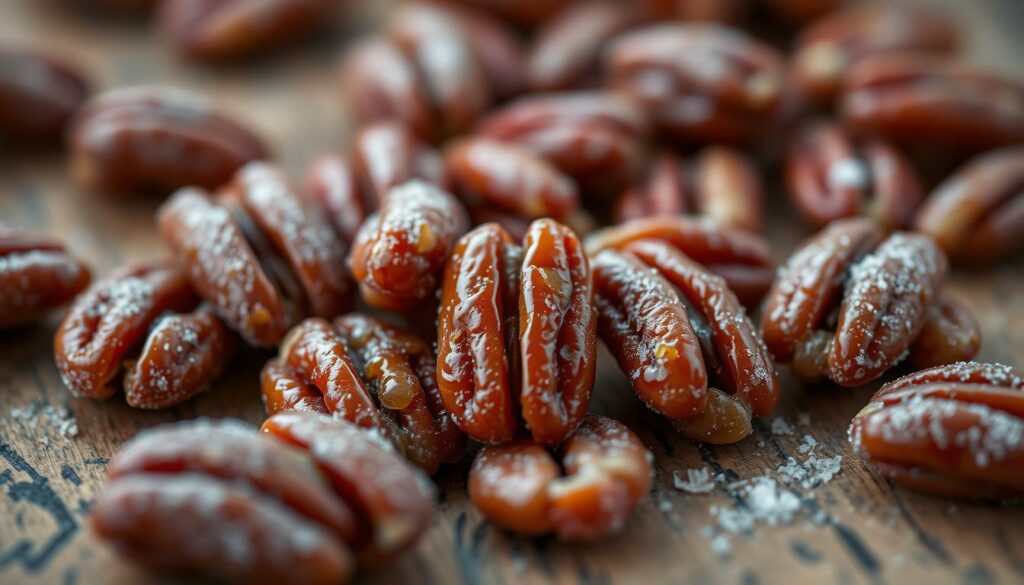Ever looked forward to crunchy candied pecans, only to find them soft and sticky? You’re not alone. Many struggle to get the perfect texture, ending up with soft, chewy nuts.
This guide will help you figure out why your candied pecans are soft. We’ll cover common issues like cooking time, temperature, and moisture. You’ll learn how to make your pecans crispy and delicious.
We’ll talk about the importance of ingredients, like the right sugar and the sugar-to-pecan ratio. We’ll also guide you through the cooking process, step by step. This will help you make crunchy candied pecans every time.
Table of contents
Key Takeaways
- Insufficient cooking time and improper temperature control can lead to soft candied pecans
- Excess moisture in the coating can prevent the pecans from crisping up properly
- Choosing the right type of sugar and balancing the ratio of sugar to pecans is crucial for texture
- Mastering the cooking process involves close monitoring and adjusting recipe components as needed
- Proper cooling and storage techniques help maintain the crispness of candied pecans over time
Understanding the Perfect Texture of Candied Pecans
Creating the perfect pecan candy recipes means getting the texture just right. You want candied pecans that are crunchy pecan topping and add a nice contrast to the nut’s rich flavor.
The best candied pecan has a crisp, caramelized outside. It should break a bit when you bite into it, showing a soft and toasted pecan inside. This mix of textures makes the nut a special treat.
“The secret to irresistible candied pecans lies in the interplay of flavors and textures – a delicate dance between sweet, crunchy, and nutty.”
Several things help get the texture right in your pecan candy recipes. The sugar type and amount, the sugar to pecan ratio, and cooking temperature and time are all important.
When done right, these factors make a shiny, even sugar shell around each pecan. This shell gets hard and crunchy pecan topping when it cools. Inside, the pecan stays soft and a bit chewy, offering a nice contrast.
Learning to make perfectly textured candied pecans opens up many uses. You can use them on ice cream sundaes, in salads, or as a snack. Their versatility is endless.
Common Reasons for Soft Candied Pecans
Ever bitten into a soft candied pecan when you wanted crunch? You’re not alone. Pecan coating issues and softness are common problems. Let’s look at the main reasons and how to fix them.
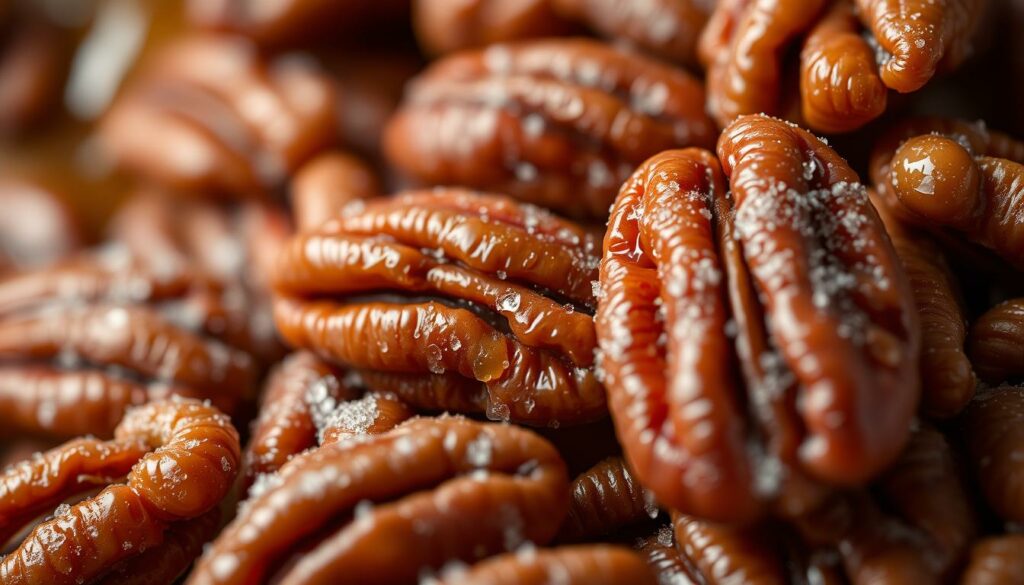
Insufficient Cooking Time
Not cooking them long enough is a big reason for soft candied pecans. The cooking process is key for the sugar to caramelize and harden. If you take them off the heat too soon, the coating stays soft and sticky.
Improper Temperature Control
Temperature control also plays a big role. Candied pecans need a specific temperature range for the perfect crunch. If it’s too low, the sugar won’t caramelize right. If it’s too high, the sugar can burn and taste bitter.
Excess Moisture in the Coating
Moisture is the enemy of crispiness in candied pecans. Too much liquid in the coating stops the sugar from hardening. This can happen if you use too much liquid sweetener or don’t dry the pecans before coating.
To get your candied pecans just right, focus on cooking time, temperature, and moisture. Fixing these common issues will help you make deliciously crunchy candied pecans.
The Role of Ingredients in Achieving Crispy Candied Pecans
Creating the perfect candied pecans starts with the ingredients. The type of sugar and the sugar-to-pecan ratio are key. Understanding these can help you avoid pecan dessert problems and make crispy treats every time.
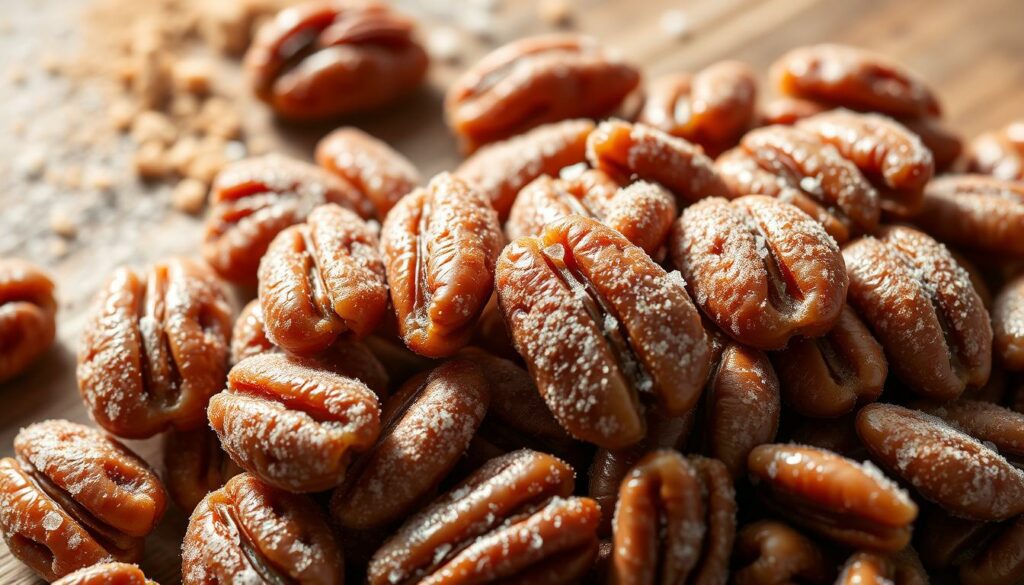
Choosing the Right Type of Sugar
The sugar you pick affects the pecans’ texture. Granulated sugar is common but might not be the crispiest. Try these alternatives:
- Brown sugar adds a deeper flavor and a stickier coating for crunch.
- Confectioners’ sugar gives a smooth, even coating that crisps up well.
- Maple syrup or honey add unique flavors and help with crispiness.
Balancing the Ratio of Sugar to Pecans
Getting the sugar-to-pecan ratio right is crucial for crunch. Too much sugar makes the coating soft and sticky. Too little sugar doesn’t cover the pecans well. Use about 1 cup of sugar for every 4 cups of pecans. Adjust this based on your taste and recipe.
Remember, aim for a thin, even sugar layer on each pecan. This helps them crisp up in the oven, giving a crunchy texture that matches their rich flavor.
Choosing the right sugar and balancing it with pecans will lead to crispy candied pecans. Say goodbye to pecan dessert problems and hello to treats that impress!
Mastering the Cooking Process for Crunchy Results
To get perfectly crunchy candied pecans, mastering the cooking process is key. Follow these tips to achieve a satisfyingly crisp texture every time.
Start by heating your oven to 350°F (175°C). Spread the pecans on a baking sheet in a single layer. Toast them for 10 to 12 minutes, until they’re deeply roasted and fragrant. This step boosts their flavor and keeps them crunchy after coating.
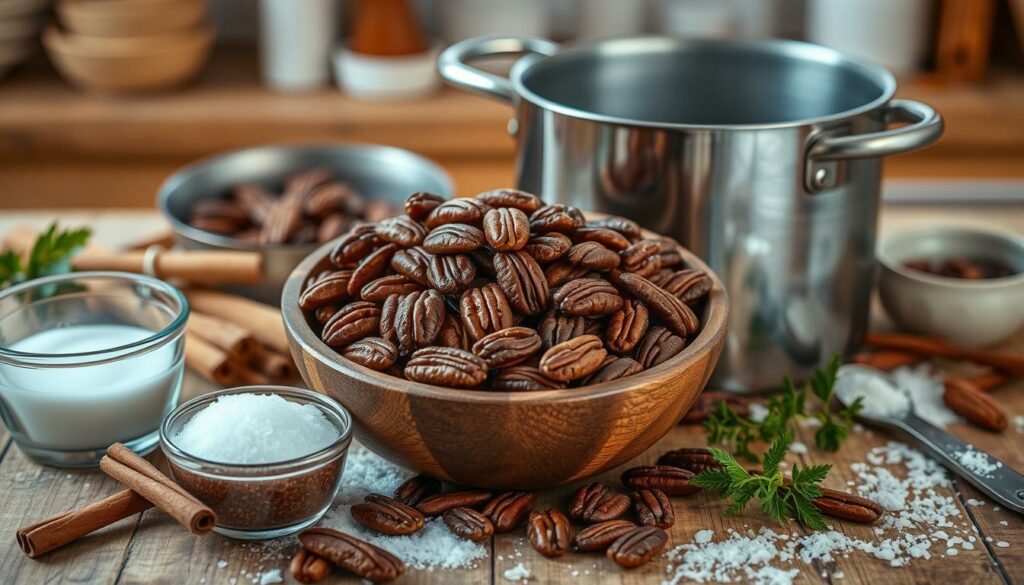
In a large skillet, mix the sugar, cinnamon, and salt. Heat it over medium, stirring constantly, until the sugar melts and caramelizes. This takes about 5 minutes. Watch closely to avoid burning, as it can turn bitter quickly.
After the sugar melts, add the toasted pecans to the skillet. Stir to coat them evenly with the sugar mixture. Cook and stir for 2 to 3 more minutes, until the sugar is deep amber and all pecans are coated.
To check if the pecans are done, take a few out and let them cool for a minute. If they’re crispy and snap easily, they’re ready. If not, cook for another minute or two, but don’t overcook to avoid bitterness.
When the pecans are crunchy, move them to a parchment-lined baking sheet. Use a fork or spatula to separate them. Let them cool completely at room temperature, which takes about 30 minutes.
Why Are My Candied Pecans Soft
Ever bitten into a soft, chewy candied pecan when you wanted crunch? You’re not alone. Many struggle to get the perfect texture in their candied pecans. Knowing why they’re soft is the first step to fixing it.
Identifying the Causes of Soft Texture
Several things can make candied pecans soft. These include:
- Not cooking them long enough, so the sugar doesn’t harden
- Not controlling the temperature right, making the coating sticky
- Too much moisture in the coating, often from high humidity or too much liquid
By figuring out why your pecans are soft, you can adjust your method and recipe. This will help you get the crunch you want.
Quick Fixes for Soft Candied Pecans
Don’t worry if your candied pecans are soft! There are quick ways to fix them:
- Put them back in the oven at 250°F for 10-15 minutes. Stir them a few times to dry out the coating.
- Spread them out on a baking sheet and chill them in the fridge for 30-60 minutes. Cold air helps the coating harden.
- If they’re still too soft, sprinkle them with powdered sugar or finely ground nuts. This absorbs moisture and adds crunch.
By fixing the soft texture issues and using these quick fixes, you’ll soon enjoy crunchy, delicious candied pecans every time.
Tips for Storing Candied Pecans to Maintain Crispness
After making candied pecans, you don’t want them to lose their crunch. Storing them right is key to keeping them crispy. Follow these simple tips to keep your candied pecans fresh and crunchy for weeks.
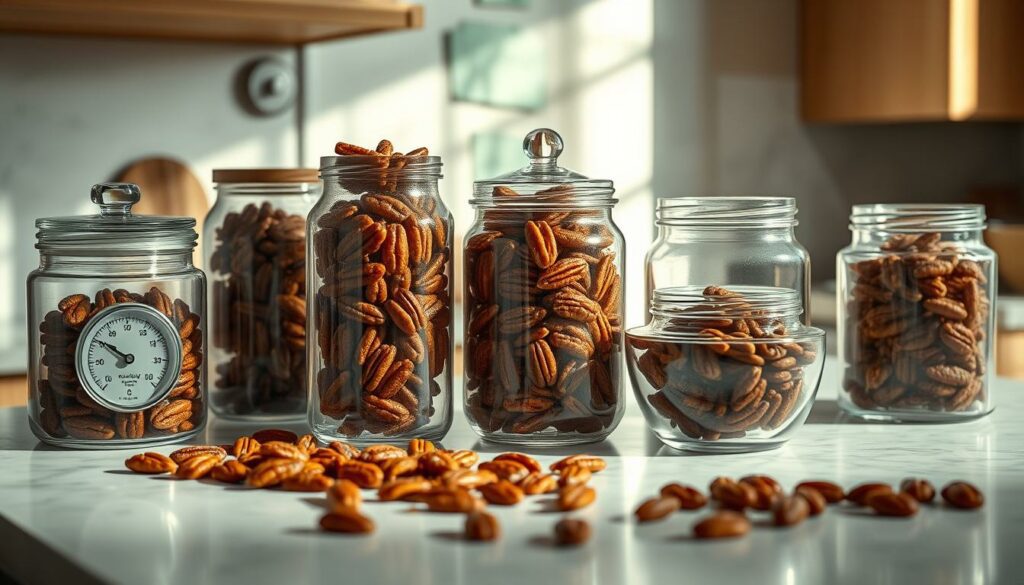
Proper Cooling Before Storage
Letting candied pecans cool completely is crucial. Spread them out on a baking sheet lined with parchment paper. This helps air circulate and prevents moisture buildup.
Be patient and wait for them to cool down. Storing warm pecans can cause them to lose their crispiness.
Airtight Containers and Desiccants
Once cool, put the pecans in an airtight container. Use mason jars, plastic containers, or resealable bags. Adding a desiccant packet can help keep them crunchy.
Desiccants, like silica gel packets, absorb moisture. You can find food-grade desiccant packets at kitchen stores or online.
Store the pecans in a cool, dry place. Keep them away from sunlight and heat. Don’t store them in the fridge, as it can make them soft. With the right storage, your candied pecans will stay crunchy for weeks.
Troubleshooting Specific Issues with Candied Pecan Texture
When making candied pecans, texture problems can pop up. Sticky pecans and uneven coatings are common issues. Let’s look at how to solve these problems.
Sticky candied pecans are a big problem. They stick together and don’t get crunchy. This usually happens because of too much moisture or not cooking them long enough. To fix this, spread them on a baking sheet and bake at 250°F for 10-15 minutes. Stir them a few times to dry them out.
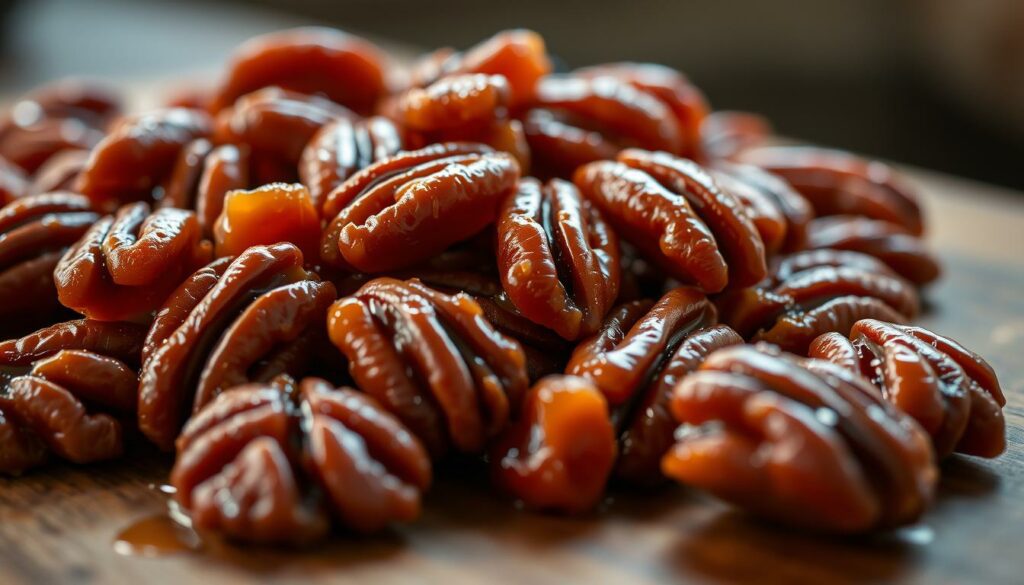
Uneven coatings are another issue. This can be due to poor sugar distribution or not stirring enough. To get an even coat, toss the pecans well in the sugar before cooking. Stir them every 5-7 minutes while baking. This ensures the coating spreads evenly.
| Texture Issue | Cause | Solution |
|---|---|---|
| Sticky pecans | Excess moisture, insufficient cooking time | Bake at low temperature for additional time |
| Uneven coating | Poor distribution of sugar mixture, infrequent stirring | Toss pecans thoroughly in mixture, stir frequently during cooking |
By tackling these texture problems, you’ll make candied pecans that are perfect. Remember, solving these issues takes patience and careful attention. This will help you get the right texture for your treats.
Variations on Classic Candied Pecan Recipes for Optimal Texture
Creating the perfect crunchy pecan toppings is all about trying new things. You can use different sugars, spices, and methods to make your pecan candy recipes better. Let’s look at some ways to get the best texture for your candied pecans.
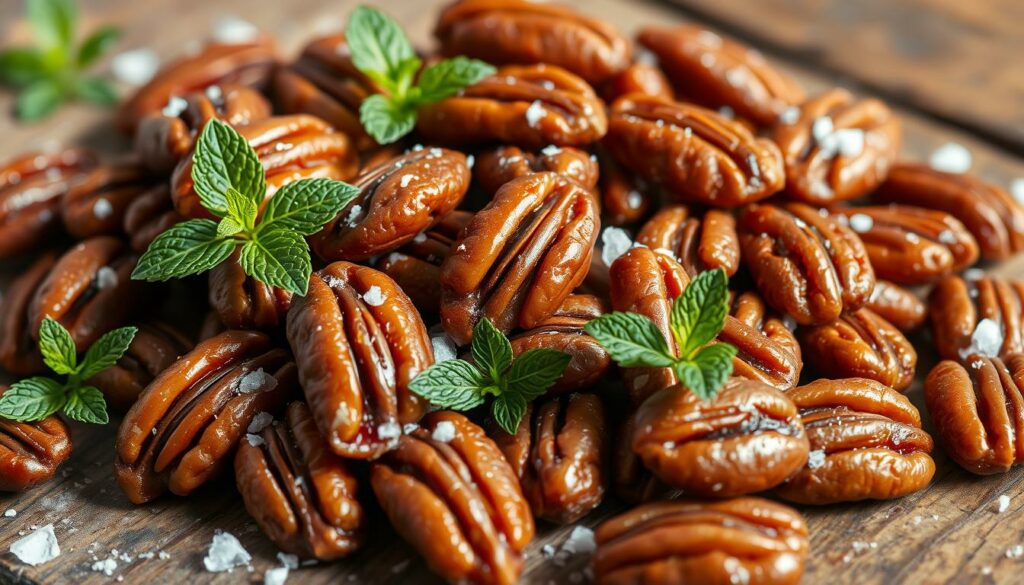
Experimenting with Different Sugars and Spices
Using various sugars and spices can make your candied pecans more interesting. Brown sugar gives a rich, caramel taste, while white sugar is sweeter and cleaner. You can mix spices like cinnamon, nutmeg, and vanilla to create unique flavors that go well with the pecans.
Here’s a simple pecan praline recipe that uses brown sugar and heavy whipping cream for a creamy texture:
| Ingredient | Quantity |
|---|---|
| Brown sugar | 1 cup |
| Heavy whipping cream | 1/2 cup |
| Salted butter | 2 tablespoons |
| Vanilla extract | 1 teaspoon |
| Pecan halves | 2 cups |
Incorporating Egg Whites for Extra Crunch
Egg whites can make your candied pecans even crunchier. Whisk egg whites until frothy, then coat the pecans. This creates a light layer that gets crispy in the oven. It’s great for making big batches of pecan candy recipes.
Try this variation on a classic candied pecan recipe that uses egg whites for a crunchy result:
- Preheat the oven to 250°F and line a baking sheet with parchment paper.
- In a large bowl, whisk one egg white until frothy.
- Add 4 cups of pecan halves to the bowl and toss to coat evenly.
- In a separate bowl, mix together 1 cup of white sugar, 1 tablespoon of cinnamon, and 1 teaspoon of salt.
- Sprinkle the sugar mixture over the pecans and toss until well coated.
- Spread the pecans in a single layer on the prepared baking sheet.
- Bake for 1 hour, stirring every 15 minutes, until the pecans are golden brown and crisp.
By trying different sugars, spices, and techniques like using egg whites, you can make many types of crunchy pecan toppings. These variations will surely please anyone with a sweet tooth.
When Soft Candied Pecans Can Be a Good Thing
While crispy candied pecans are often the goal, there are times when a softer texture can be desirable. Soft candied pecans offer a unique mouthfeel. They can be the perfect addition to certain recipes or applications.
One instance where soft candied pecans shine is in ice cream toppings. The slightly softer texture allows the pecans to blend seamlessly with the creamy ice cream. This creates a harmonious combination of flavors and textures. The soft candied pecans won’t overpower the delicate nature of the ice cream, making them an ideal choice for this sweet treat.
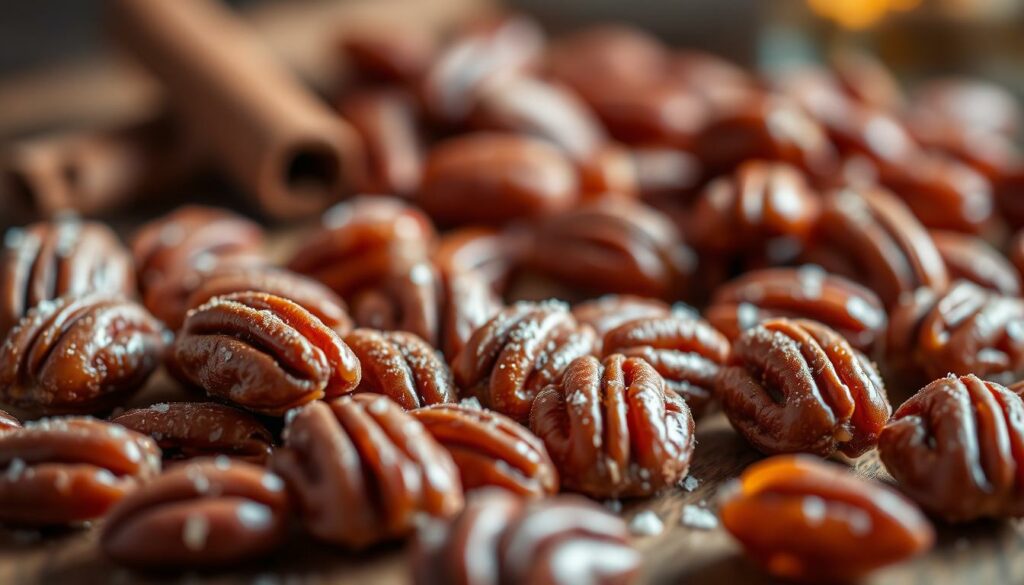
Another scenario where softer candied pecans can be advantageous is in baked goods, such as cookies or brownies. The moisture from the batter can soften the pecans during the baking process. This results in a delightfully chewy texture that complements the overall dessert. Here’s a comparison of how soft candied pecans fare in different baked goods:
| Baked Good | Texture with Soft Candied Pecans |
|---|---|
| Chocolate Chip Cookies | Chewy and gooey, enhancing the overall texture |
| Brownies | Soft and fudgy, blending seamlessly with the dense brownie batter |
| Pecan Pie | Tender and delicate, complementing the rich filling |
To achieve a softer texture intentionally, you can modify your candied pecan recipe slightly. Reduce the cooking time by a few minutes, allowing the pecans to retain some moisture. Additionally, consider using a higher ratio of brown sugar to white sugar. Brown sugar tends to create a softer, chewier texture due to its molasses content.
The beauty of soft candied pecans lies in their versatility. They offer a delightful twist on the classic crunchy version, adding a new dimension to your favorite recipes.
Embracing the softer side of candied pecans opens up a world of culinary possibilities. Whether you’re topping a sundae or baking a batch of cookies, don’t be afraid to experiment with a softer texture. Discover the delicious results for yourself.
Preventing Soft Candied Pecans: A Step-by-Step Guide
To get perfectly crispy candied pecans, follow some key steps. Paying attention to details helps avoid a soft texture. This way, you achieve the perfect pecan brittleness.
Preparing the Pecans for Optimal Results
Start by picking fresh, high-quality pecans. They should be the same size. If they’re raw, toast them lightly to boost flavor and crunch.
This step reduces moisture. It makes your candied pecans crunchier.
“The key to achieving the perfect crunch in candied pecans lies in the preparation and attention to detail during the cooking process.” – Chef Emily Thompson
Monitoring the Cooking Process Closely
Keep an eye on your pecans while they cook. Sugar syrup can burn quickly if you’re not watching. Use a candy thermometer to check the syrup’s temperature.
Stir the pecans often to coat them evenly. This prevents burning. As you cook more, you’ll know when they’re done.
Adjusting Recipe Components as Needed
Even with careful prep and watching, you might need to tweak the recipe. If pecans are too soft, try less liquid or cook them longer. You can also try different sugars or egg whites for a crisper coating.
Don’t hesitate to make small changes to your recipe. This will help you get the perfect crunch and flavor.
By following these pecan cooking tips, you can avoid soft candied pecans. With practice, you’ll make delicious, crunchy treats every time.
Conclusion
Understanding why candied pecans might be soft is key to getting them crunchy. Issues like not cooking them long enough, wrong temperature, and too much moisture can cause softness. The right ingredients, like sugar type, and the right sugar to pecan ratio are also important.
Getting the cooking process right is crucial for crispness. Cool them down before storing and use airtight containers with desiccants. Trying different sugars, spices, or egg whites in recipes can also improve texture and taste.
While soft candied pecans can be nice, the goal is often to get them crunchy. Follow a guide that includes preparing the pecans and watching the cooking closely. Adjusting the recipe as needed helps avoid softness. With practice, you’ll make candied pecans that are perfectly crunchy.
FAQ
How can I achieve the perfect texture for my candied pecans?
To get the perfect texture, cook them well and at the right temperature. Use the right sugar-to-pecan ratio. Stir often and let them cool completely before storing.
What are the most common reasons for soft candied pecans?
Soft candied pecans often come from not cooking them enough or not controlling the temperature right. Also, too much moisture in the coating can cause it. Stick to the recipe and adjust as needed.
What type of sugar should I use for crispy candied pecans?
Choosing the right sugar is key for crispy pecans. Granulated, brown sugar, or a mix works well. Avoid powdered sugar or liquid sweeteners for a softer texture.
How do I store candied pecans to maintain their crispness?
To keep them crisp, cool them down first. Then, put them in an airtight container. Adding a desiccant packet helps. Store in a cool, dry place, away from sunlight.
Can I fix soft candied pecans after they’ve been cooked?
Yes, you can crisp up soft pecans by reheating them. Try 250°F (120°C) for 10-15 minutes. Watch them to avoid burning.
Are there any variations on classic candied pecan recipes that can improve texture?
Yes, trying different sugars and spices can improve texture. Adding egg whites to the coating also makes them crisper.
Is it ever okay for candied pecans to have a slightly soft texture?
Sometimes, a softer texture is okay, depending on what you’re using them for. For example, they’re great on ice cream or in trail mix.

